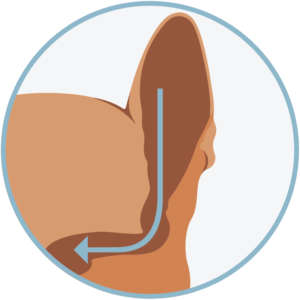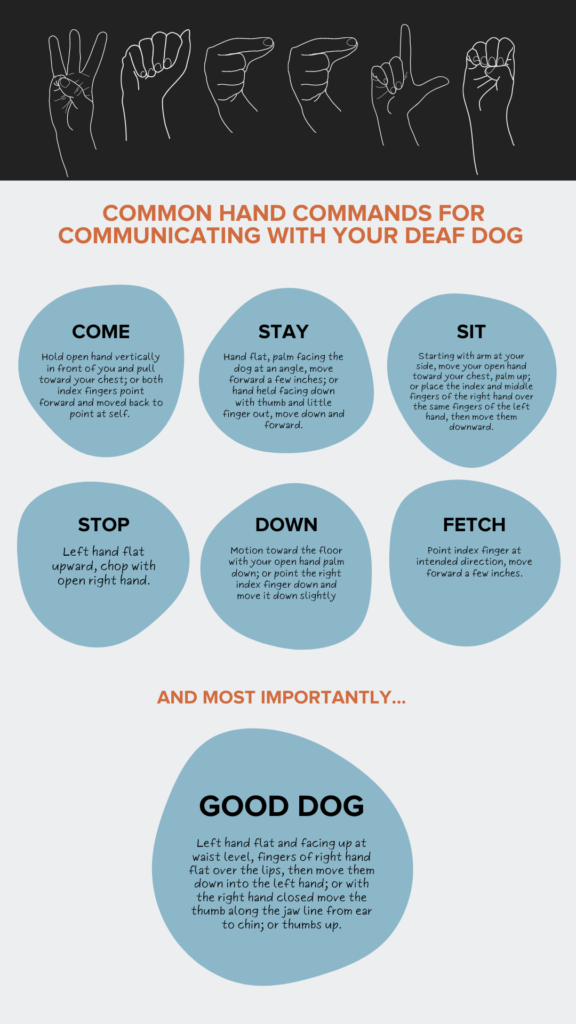Deaf dogs: How to raise them and why we love them
Some dogs are so good at selective listening that it can be hard to tell if your dog is deaf (or just defiant).
Deafness is the inability to perceive sound. It can come about in a variety of ways and severity. In this post we’ll help you answer the question, “How do I know if my dog is deaf?” by exploring these causes or culprits. We’ll also hear from one of our Waggle Mail dog subscription box family members, Tamara, about her and her husband’s experience parenting their darling deaf dog, Kaia.
We’ll start with a quick anatomy lesson.
How do dogs hear?
At birth, puppies’ ear canals are closed shut. They typically open between 12-14; not surprisingly, this coincides with when they first start to hear.
Like humans, sound waves from the environment funnel through dogs’ external ear canal and cause vibrations of the eardrum (also known as the tympanic membrane). These vibrations are then transmitted through the middle ear auditory bones into the inner ear, where they stimulate nerves that notify the brain of sound.
EXPERT TIP: Think you’ve got a keen ear? Your dog has you beat! The frequency range for hearing in humans is around 64-23,000 Hz, whereas dogs come in at almost double the upper range with 67-45,000 Hz!

With hearing that good, why isn’t your dog listening?
How do I know if my dog is deaf?
Call us biased, but we think dogs are pretty amazing animals. It’s impressive how well they can get along even without full command of senses like sight or hearing.
It can be tough to catch cues of possible dog deafness, especially if those cues are mild or slowly progress over time.
It’s especially difficult when you aren’t sure if what’s really going on is a case of selective listening—ignoring you when it’s time to go out for a pee in the rain, but racing across the house at the sound of a chip bag being opened.
How to tell if your dog is deaf
Especially when dogs are born deaf, there generally aren’t a ton of symptoms to easily pick up on. Some things you may notice at home include:
EXPERT TIP: If you’re currently on a deafness diagnosis journey, check out the Deafness in Dogs website. They’re a treasure trove of information on specialty tests like BAER (Brain Stem Auditory Evoked Response Test—try saying that one three times fast!) and where to access them across North America.
- Difficulty waking up to or with words
- Difficulty determining where sounds are coming from
- Increased vocalization and more aggressive play than littermates
- Disorientation and agitation (mostly in senior dogs)
If any of these look or sound like your dog, we recommend booking in an ear exam with your family veterinarian. Clinicians have special tools like otoscopes that will help visualize both the ear canals and ear drums. Often, a thorough history along with a physical and neurological exam are all necessary to make a firm diagnosis. Some vets may also recommend bloodwork or a specialist referral for additional testing.
What causes deafness in dogs?
Not only is diagnosing dog deafness difficult, it can also be tough to identify what’s responsible.
Possible causes of deafness in dogs can be broken down into the following categories:
EXPERT TIP: If you’re wondering, “Can dogs go deaf from ear infections?” the answer, unfortunately, is yes. Ear infections are a prime example of conductive deafness, which is why we encourage dog parents to take their pets in for routine veterinary check-ups!
- Conductive deafness. This category usually happens later in a dog’s life and is acquired or caused by something (trauma-induced fluid build-up, ear drum damage, or cancer, for example).
- Sensorineural deafness. This type of deafness can be inherited or acquired by something like chronic exposure to loud noise, trauma, or an underlying medical condition such as hypothyroidism (an underactive thyroid gland).
- Congenital, inherited sensorineural deafness. Think of this as the “born this way” category. Some puppies can experience total loss of hearing as early as 5 weeks old. This can happen in one or both ears, and is often associated with the genes responsible for white and merle coats, which brings us to a particularly popular pet parent question…
What percentage of white dogs are deaf?
Before we answer this, it’s important to point out that dogs of any colour or breed can experience congenital or acquired deafness. We’re not sharing this information to discourage you from adopting a new family member with a white or merle coat—after all, all dogs are deserving of a warm, welcoming home. Our goal is always to support dog parents through their questions, concerns, and challenges.
Researchers have found that breeds with white pigmentation are most affected by deafness. Results from a genome-wide association study (GWAS) identified possible genetic associations with dalmations, English setters, and Australian cattle dogs. It turns out that genetics and coat colour are tightly knit and pretty complex!
As for sex differences, there have been studies to support a slightly higher prevalence of deafness in females over males, but this one requires further research.
Dalmatians have one of the highest reported prevalence of deafness (18.4-30%), and in some studies females appear to be more affected than males.
How to get a deaf dog’s attention?
EXPERT TIP: Want to be an even more hands-on communicator with your dog (pun intended)? Consider brushing up on your ASL (American Sign Language)! This can open up a whole new world of words for you and your dog.
Whether congenital or acquired, if you’re a parent to a deaf dog you’ll know the struggle of getting a deaf dog’s attention. Don’t be discouraged! Some parents worry communication will be impossible, but that’s simply not the case. Sure, you may need to get creative with your communication, but on the whole dogs are very perceptive creatures and read body language like pros.
Words aren’t the only way to connect with your dog. Try thumping on the floor with your foot, waving, or using a flashlight (not too bright, please!) to get your deaf dog’s attention.
Here are a few key hand commands to help get—and keep—your deaf dog’s attention:

How to raise a deaf dog
Raising and training a deaf dog requires commitment and plenty of patience. In many ways, it’s no different to bringing home a new puppy. Your deaf dog will surprise you with how well they adapt to life without hearing… and what a great way to develop an even deeper bond with your extra special pup.
First, let’s cover some safety basics:
- Deaf dogs should always be leashed and/or safely fenced when outside. As a parent to a deaf dog, it’s important you remain vigilant of yours and your dog’s surroundings, particularly when the two of you are somewhere new.
EXPERT TIP: Always be sure to gently remind strangers and guests—especially children—not to disturb your dog when they’re sleeping. People from dog-free homes or with hearing dogs aren’t attuned to risk in the same way you are.
- Invest in a deafness dog tag and dog bell. A dog tag that lets people know your dog is deaf will help them react appropriately should they find your escape artist wandering the park. Bells are also helpful to know when your deaf dog is on the move.
- Hire a trainer. If you’re struggling to DIY, enlist the help of a professional. Keep your training sessions short (about 15 minutes each time) and trust in the process. Before you know it, your dog will have dozens of commands under their belt!
- Wake your dog with care. The last thing you want to do is startle a deaf dog awake. A touch on the shoulder or placing your hand in front of their nose will gently nudge them awake.
A Q&A with Tamara and Kaia
What do all these tips and techniques look like in practice? We reached out to one of our subscribers, Tamara, to chat about life with Kaia, a toy Aussie with congenital deafness.
How did Kaia come into your life?
When my husband and I got married in 2018, we decided it was time to add another dog to our lives. My husband fell in love with Kaia the first time he saw a photo of her. We got everything in order and planned a trip to Oregon to pick her up in September.
We brought her home and she fit seamlessly into our life. She loved her ‘big sister’, Lilly, and my sister’s little Yorkie, Lexi. However, by the end of October we began to wonder if Kaia had difficulty hearing things. Because she followed her doggie friends around and paid very close attention to them, it was tough for us to tell but we began “testing” her hearing by making noises when she wasn’t looking or when she was asleep.
Kaia’s veterinarian confirmed Kaia couldn’t hear, but that hasn’t stopped her or us from making the most of what has been an absolutely wonderful four years together!
What is the most challenging part of raising a deaf dog?
This is hard to answer because we haven’t had a challenge, per se. Sure, we’ve adjusted to life with a deaf dog, but Kaia is smart as can be.
Because it took us a while to realize she was deaf, Kaia had long since picked up on our body language. We do some signing with her, too, and that works well for us.
Kaia is a very attached dog and has some separation anxiety. She does great with family and friends, but prefers us to all be together. When Kaia is anxious she has a habit of making some pretty loud, unusual noises—a bit like a cross between a Husky and a velociraptor! We chalk this up to her personality and lack of hearing; although it took some getting used to, we absolutely adore her quirky sounds.
What is the most rewarding part of raising a deaf dog?
Having a deaf dog is incredible. We hope to be able to always give one a loving home.
We love being able to spread awareness about deaf dogs. I tell people all the time that Kaia is no different than a hearing dog. Her deafness doesn’t slow her down one bit! In fact, we’re in the process of getting Kaia her therapy dog status because she truly is such a kind dog with a loving, calming process. It’s her calling!
If you’re looking for support, there is a whole community online dedicated to families with deaf dogs. It’s a wonderful place that has helped us connect with others and have a sounding board for questions that have come up over the years.
What strategies have helped you and Kaia most?
Our best strategies have been using a version of sign language that works for us. We don’t use standard sign language for all of her signs, and that’s okay. It’s really a matter of doing what works for you and your dog. It’s also been cool to see how Lilly and the other dogs in our lives have started to pick up on these signs, too.
We’ve chosen to use harnesses as an added safety measure whenever Kaia is out and about. It gives us peace of mind. We attach her to a long-line leash so she gets a taste of what it’s like to freely roam without being off-leash.
Luckily for us, Kaia is very food motivated so choosing healthy treats has been a huge help in teaching her the signs she needs for daily living.
What advice would you give to dog parents considering adopting a deaf dog (or whose dog has recently gone deaf)?
Be patient and pay attention to your facial expressions and body language, as these are the main cues your dog will pick up on. Give them a thumbs up, a smile, and some pets when they do well so they know they’re on the right track.
Don’t forget to keep talking to your dog. It’s the easiest way for us to express ourselves, and dogs can still tap into how we’re feeling.
If your senior dog is starting to lose their hearing, take the time to start incorporating signs along with your commands. It will make the transition easier for everyone.
Anytime you’re training, always end on a good note. Even if they only did what you asked one time, that praise is something they’ll remember tomorrow.
If you’re looking to adopt, consider a deaf dog! They will bring so much joy to your life. Unfortunately, deaf dogs have a harder time finding a home, but trust me: they’ll fill yours with so much love. We couldn’t imagine our house or our lives without Kaia.

Like what you read? Send this article to a friend and subscribe to Waggle (e)Mail. We’re here to support dog parents every step of the way.

